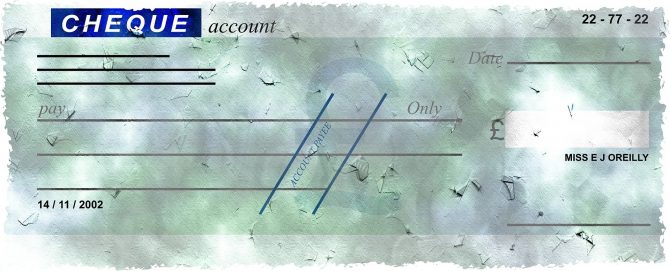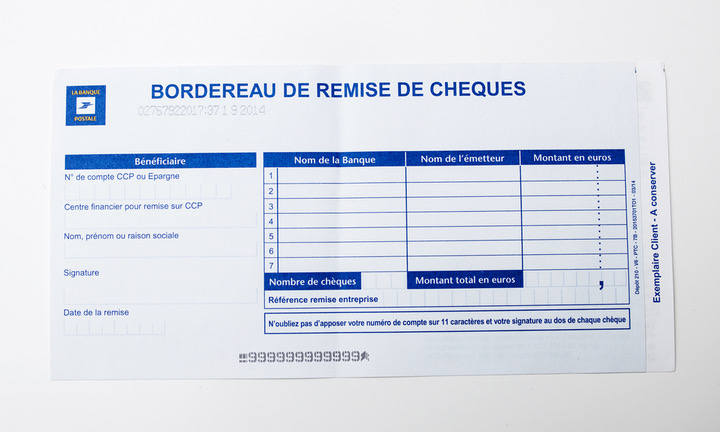How To Cash a Cheque in France
Essential Reading


When you first arrive in France, everyday tasks that seemed so simple in your own country can suddenly feel quite new and challenging. Once you’ve learnt how to write a French cheque or make a bank transfer, the next step is learning to cash a cheque in France. Don’t worry—this easy-to-follow guide has you covered!
Receiving a Payment by Cheque in France
Cheque payments are still quite common in France and there are many occasions when you might receive a cheque. If you are self-employed as an auto-entrepreneur or run a small business, you might find you receive some of your payments in the form of a cheque. Private sales via leboncoin or similar may result in a cheque being paid, and even a French friend who owes you money might opt to write a cheque.
Generally speaking, the cheque is a more reliable and safe form of payment in France in comparison to some other countries. It is illegal in France to write a cheque without sufficient funds in your bank account to back it up and there can be quite serious consequences for doing so. Therefore, genuine buyers or clients would not want to run the risk of a cheque bouncing.
That’s not to say it never happens, however, so it pays to use common sense and exercise caution. If you would prefer to receive your payments via bank transfer or in cash, you have the right to ask for a different payment method.
If accepting a large payment from a stranger (for example, when selling a car via a private sale), you could also consider asking for un chèque de banque’, a banker’s or cashier’s cheque. This kind of cheque is guaranteed by the bank, so you can be certain that the payment will go through. However, they can take up to two days for the buyer to receive, so you need to give them plenty of time to organise it.
When you receive a cheque in France, you should verify that the amount is correct, that the date has been filled in (un-dated or post-dated cheques are illegal in France too), and that it has been signed. However, it is quite common to leave the beneficiary’s name (your name or that of your business) blank, especially if the buyer is unsure of who to address the cheque. If this is the case, be sure you fill this in before you try to cash it!
How to Cash Your French Cheque
French cheques are valid for one year (12 months) and 8 days, which should give you plenty of time to cash it. Don’t miss the deadline, though—after that date, the cheque will be void.
To cash a cheque, you will need to go to your bank (or any branch of your bank). Most banks have one of two ways to cash a cheque (or ‘encaisser une chèque’ in French):
- Using a cheque-deposit machine (un Guichet Automatique de Banque)
- Manually at a self-deposit desk (une urne)
Your bank will have one of these two options and they should be easy to find, right by the ATMs, and marked ‘Remise de Chèques’. It is not generally possible to deposit a cheque with a bank teller at the main counter, so don’t waste your time queuing—you will only be redirected to the machine or self-deposit desk to do it yourself!
Writing on the back of the cheque
The first thing you need to do is write your full account number on the back of the cheque (the blank side).
For a CCP (current account) this will be 7 numbers + 1 letter + 3 numbers
For example: 0000000A000
For a Compte Epargne (Livret A/PEL/…) (a savings account) this will be 10 numbers + 1 letter.
For example: 0000000000A
You then add your signature below this.
Don’t forget to do this!
Using the Guichet Automatique de Banque
If you are cashing a French cheque using an automatic machine, you will need to insert your bank card and enter your pin code. You will be asked to enter certain details such as the number of cheques you are depositing, the amount on each cheque, and your bank location. If unsure, you can find all the information on your bank RIB or on the cheque you are cashing.
You will be asked to confirm these details, then deposit your cheque (which you have already signed and added your bank number to) into the tray indicted. You do not need to fill in the bordereau de remise de cheques (see below).
You will receive a receipt to confirm that your cheque has been deposited. Hold onto this until your cheque has cleared.
Filling in the Bordereau de Remise de Chèques

If you are cashing a French cheque manually, you will need to fill in a bordereau de remise de chèques (cheque remittance slip). These are all slightly different, depending on your bank, but will generally all ask for the same information. Here’s how to fill it in:
On the right-hand side, fill in the ‘bénéficiare’ (you or the person/account to which you are depositing the cheque) section:
- de Compte CCP ou Epargne (the number of your current or savings account – the same one you just wrote on the back of the cheque!)
- Centre financier sur CCP (for a current account, the account holding branch. This is typically the city/town, but it will be marked on your RIB)
- Your signature
- Today’s date
On the left-hand side fill in the details of the cheque or cheques to cash:
- Nom de la Banque (the name of the bank) – this is the bank of the cheque being deposited not your bank!
- Nom de l’emetteur (the name of the person who wrote you the cheque, as it’s written on the cheque)
- Montant en Euros (the cheque amount in euros)
- Nombre de chèques (the total number of cheques you are cashing). If you are cashing just one cheque you should still fill this in.
- Montant total en Euros (the total amount of the cheques you are cashing). If you’re cashing just one cheque, you should still fill this in.
Once you’ve filled in all the details and double-checked it, tear off the copy titled ‘Exemplaire Client – A conserver’. This is your copy and serves as your receipt, so hold onto it until the cheque has cleared.
You then insert your cheque into the pouch on the back of the bordereau.
Important! Before you deposit your cheque, you must stamp the bordereau by inserting it into the horodateur (the timestamp machine, which you’ll find by the urne).
Now deposit the bordereau and cheque into the ‘urne’, normally just a slot with a large arrow saying ‘remise de chèques’ (or something similar). That’s it!
Cheques typically take two to three working days to clear, but they may take longer depending on your bank.
Can you deposit a UK or American cheque into a French bank account?
It’s not generally possible to deposit a UK* or American cheque into a French bank account and you will probably find most banks turn down any requests. In particular, smaller banks or banks in rural areas (especially where they would be unlikely to have dealt with this kind of request before) are very unlikely to accept an international cheque.
If you are planning to receive money from the UK, US or another country, it is highly recommended to organise a different form of payment (visit our French Currency zone for advice on this).
However, if you have already received a cheque and don’t have a way to deposit it in the country of origin, it may be possible to deposit it in some French banks. The best bet is to try larger banks or international banks in a big city. Most do not advertise this service as being available, but some have been reported to do so. You should expect to be charged a fee for this, so it might not be worth it on smaller cheque amounts, and it may take a longer time than usual to clear. If the cheque bounces, there will likely be another fee payable. You will also, of course, need to open a bank account with the bank in question if you do not already.
*Be aware that although some UK cheques may be written in Euros, these are still Euro cheques destined for UK bank accounts only. They will still be counted as an international cheque if you try and deposit it in France.
Setting Up Your Finances in France
Managing your finances in a foreign country can feel like a constant challenge, but FrenchEntrée is here to help! Whether you need advice on paying French taxes, taking out insurance, or managing your wealth, our handy Essential Reading guides, expert FAQs, and up-to-date news reports will answer all your questions. And if we don’t have the answers, we can connect you with our trusted financial advisors.
Share to: Facebook Twitter LinkedIn Email



